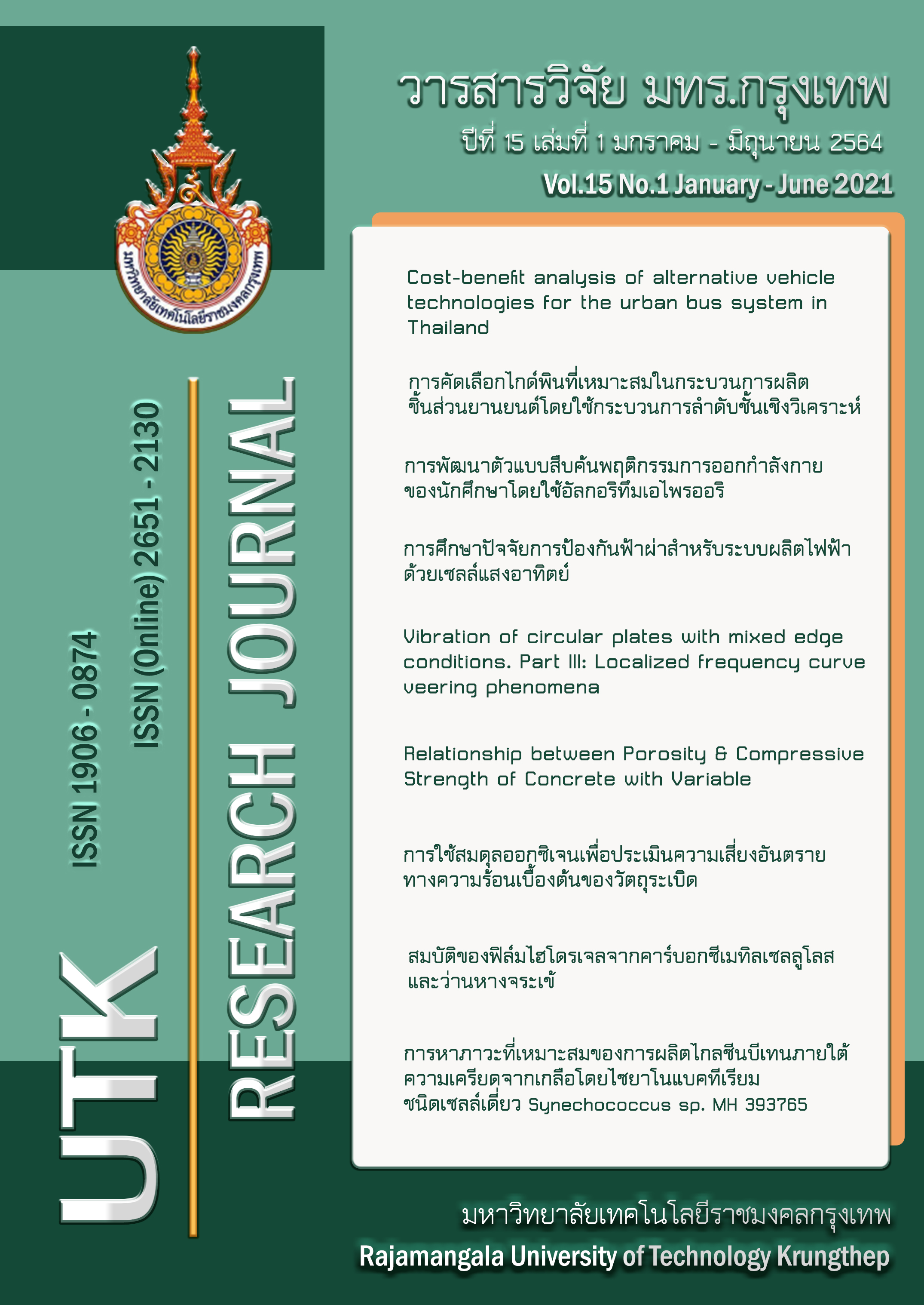การใช้สมดุลออกซิเจนเพื่อประเมินความเสี่ยงอันตรายทางความร้อนเบื้องต้นของวัตถุระเบิด
คำสำคัญ:
วัตถุระเบิด, การประเมินความเสี่ยง, สมดุลออกซิเจนบทคัดย่อ
วัตถุระเบิดที่ประกอบด้วยสารไฮโดรคาร์บอนเมื่อเกิดการสลายตัวทางความร้อน มีการแตกตัวออกไปเป็นโมเลกุลขนาดเล็กที่มีความเสถียร การประเมินความเสี่ยงเบื้องต้นของวัตถุระเบิดสามารถทำได้โดยการพิจารณาความรุนแรงต่อการระเบิด และโอกาสของการระเบิด ซึ่งประเมินจากสมดุลออกซิเจนและระดับความเป็นอันตราย ตามลำดับ ตัวอย่างวัตถุระเบิด 15 ชนิด ทำนายจากสมการซึ่งเขียนขึ้นมาอย่างง่ายโดยโปรแกรมไมโครซอฟท์ เอกซ์เซล สมดุลออกซิเจนแสดงตัวเลขบวก ลบและศูนย์ ในขณะความเป็นอันตรายปรากฏตัวอักษรในระดับต่ำ ปานกลางและสูง
เอกสารอ้างอิง
สุคนธ์ทิพย์ เพ็งโฉม, โมไนย สุขแสงธรร, ศิริศาส เอื้อใจ และคณะ. การประเมินอันตรายทางความร้อนของไฮโดรเจนเปอร์ออกไซด์ความเข้มข้นต่ำโดยดิฟเฟอเรนเชียลสแกนนิงแคลอริมิเตอร์. วารสารวิศวกรรมศาสตร์ มหาวิทยาลัยสยาม. 2560; 18(1): 62-9.
Espindola-Calderon CA, Patel SJ, Alkhawaldeh A, et al. QSPR studies using genetic function approximation to predict the chemical reactivity of noncyclic hydrazines. Journal of Safety, Health & Environmental research. 2012; 8(2): 34-42.
Suna Q, Jianga J, Li M, et al. Assessment on thermal hazards of reactive chemicals in industry: State of the Art and perspectives. Prog. Energy Combust Sci. 2020; 78: 100832.
Bender HF, Eisenbarth P. Harardous chemicals: Control and regulation in the European market. Weinheim: Wiley-VCH Verlag GmbH&Co. KGaA; 2007.
Boelhouwer E, Davis J, Franco-Watkins A, et al. Comprehension of hazard communication: Effects of pictograms on safety data sheet and labels. J Saf Res. 2013; 46: 145-55.
Fondren NS, Fondren ZT, Unruh DK, et al. Study of physicochemical and explosive properties of a 2,4,6-trinitrotoluene/aniline cocrystal solvate. Cryst Growth & Des. 2020; 20(1): 116–29.
Pepekin VI, Korsunskii BL, Denisaev AA. Energy characteristics of initiation of explosion. Dokl Phys Chem. 2008; 420: 104-5.
Gustin JL. Thermal stability screening and reaction calorimetry: Application to runaway reaction hazard assessment and process safety management. J Loss Prev Process Ind 1993; 6(5): 275-91.
Clark DE. Peroxides and peroxide-forming compounds. Chem Health Safety. 2001; 8(5): 12-22.
Akhavan J. The chemistry of explosives. 3 rd ed. Cambridge: The Royal Society of Chemistry; 2011.
Urben PG, Pitt MJ. Bretherick's Handbook of Reactive Chemical Hazards, Vol. 2, 7th ed. Amsterdam: Elsevier; 2007.
Muthurajan H, Sivabalan R, Talawar MB, et al. Prediction of heat of formation and related parameters of high energy materials. J Hazard Mater. 2006; 133: 30–45
Lothrop WC, Handrick GR. The relationship between performance and constitution of pure organic explosive compounds. Chem Rev. 1949; 44: 419-445.
Shanley ES, Melhem GA. The oxygen balance criterion for thermal hazards assessment. Process Saf Prog. 1995; 14(1): 29-31.
Saraf SR, Rogers WJ, Mannan MS. Prediction of reactive hazards based on molecular structure. J Hazard Mater. 2003; 98: 15-29.
Mannan S. Lees’Process Safety Essentials: Hazard Identification, Assessment and Control. Amsterdam: Butterworth-Heinemann; 2014.
Oluwoye I, Dlugogorski BZ, Gore J, et al. Atmospheric emission of NOx from mining explosives. Atmos Environ. 2017; 167: 81-96.
Zawadzka-Małota I. Testing of mining explosives with regard to the content of carbon oxides and nitrogen oxides in their detonation products. J Sustain Min. 2015; 14: 173-8.
Billo EJ. Excel for Chemists: A Comprehensive Guide. 2nd ed. New York: Wiley-VCH; 2001.
Larsen RW. Engineering with Excel. 4th ed. Essex: Pearson; 2014.
He P, Zhang JG, Wang K, et al. Combination multinitrogen with good oxygen balance: Molecule and synthesis design of polynitro-substituted tetrazolotriazine-based energetic compounds. J Org Chem. 2015; 80(11): 5643-51.
International Labour Organization (ILO) [Internet]. ICSC database: International Chemical Safety Cards. c1996-2018 [cited 2021 April 19]. Available from: https://www.ilo.org/dyn/icsc/showcard.listcards3?p_lang=en
ดาวน์โหลด
เผยแพร่แล้ว
รูปแบบการอ้างอิง
ฉบับ
ประเภทบทความ
สัญญาอนุญาต
กองบรรณาธิการวารสารวิชาการ มหาวิทยาลัยเทคโนโลยีราชมงคลกรุงเทพ มีความยินดีที่จะรับบทความจากอาจารย์ นักวิจัย นักวิชาการทั้งภายในและภายนอกมหาวิทยาลัย ในสาขาวิชาวิทยาศาสตร์และเทคโนโลยี ได้แก่ สาขาวิชาวิทยาศาสตร์ วิศวกรรมศาสตร์ และสาขาอื่นๆ ที่เกี่ยวข้อง รวมถึงสาขาต่างๆ ที่มีการบูรณาการข้ามศาสตร์ที่เกี่ยวข้องวิทยาศาสตร์และเทคโนโลยี ที่เขียนเป็นภาษาไทยหรือภาษาอังกฤษ ซึ่งผลงานวิชาการที่ส่งมาขอตีพิมพ์ต้องไม่เคยเผยแพร่ในสิ่งพิมพ์อื่นใดมาก่อน และต้องไม่อยู่ในระหว่างการพิจารณาของวารสารอื่น
การละเมิดลิขสิทธิ์ถือเป็นความรับผิดชอบของผู้ส่งบทความโดยตรง บทความที่ได้รับการตีพิมพ์ต้องผ่านการพิจารณากลั่นกรองคุณภาพจากผู้ทรงคุณวุฒิและได้รับความเห็นชอบจากกองบรรณาธิการ
ข้อความที่ปรากฏอยู่ในแต่ละบทความที่ตีพิมพ์ในวารสารวิชาการเล่มนี้ เป็นความคิดเห็นส่วนตัวของผู้เขียนแต่ละท่าน ไม่เกี่ยวข้องกับมหาวิทยาลัยเทคโนโลยีราชมงคลกรุงเทพแต่อย่างใด ความรับผิดชอบด้านเนื้อหาและการตรวจร่างบทความแต่ละบทความเป็นของผู้เขียนแต่ละท่าน หากมีความผิดพลาดใดๆ ผู้เขียนแต่ละท่านจะต้องรับผิดชอบบทความของตนเองแต่ผู้เดียว
กองบรรณาธิการขอสงวนสิทธิ์มิให้นำเนื้อหา หรือข้อคิดเห็นใดๆ ของบทความในวารสารวิชาการ มหาวิทยาลัยเทคโนโลยีราชมงคลกรุงเทพ ไปเผยแพร่ก่อนได้รับอนุญาตจากกองบรรณาธิการ อย่างเป็นลายลักษณ์อักษร ผลงานที่ได้รับการตีพิมพ์ถือเป็นลิขสิทธิ์ของวารสาร






